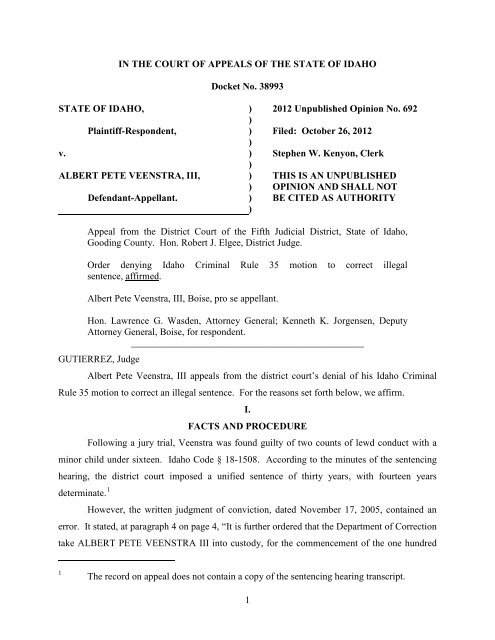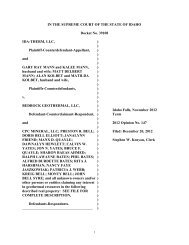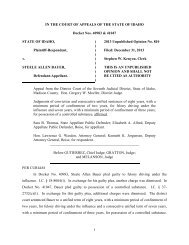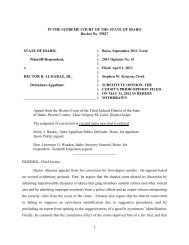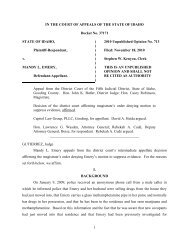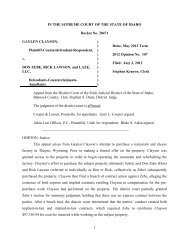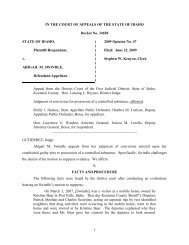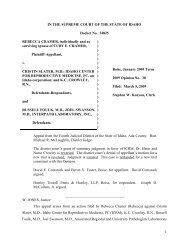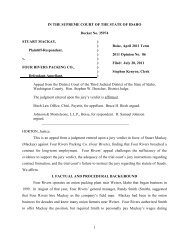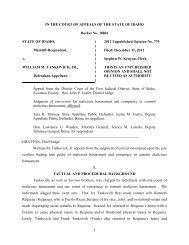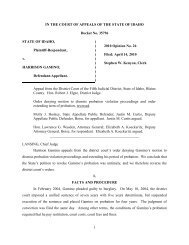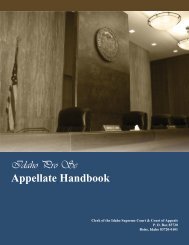State v. Albert Pete Veenstra, III - Idaho State Judiciary
State v. Albert Pete Veenstra, III - Idaho State Judiciary
State v. Albert Pete Veenstra, III - Idaho State Judiciary
Create successful ePaper yourself
Turn your PDF publications into a flip-book with our unique Google optimized e-Paper software.
STATE OF IDAHO,<br />
v.<br />
IN THE COURT OF APPEALS OF THE STATE OF IDAHO<br />
Plaintiff-Respondent,<br />
ALBERT PETE VEENSTRA, <strong>III</strong>,<br />
Defendant-Appellant.<br />
Docket No. 38993<br />
)<br />
)<br />
)<br />
)<br />
)<br />
)<br />
)<br />
)<br />
)<br />
)<br />
1<br />
2012 Unpublished Opinion No. 692<br />
Filed: October 26, 2012<br />
Stephen W. Kenyon, Clerk<br />
THIS IS AN UNPUBLISHED<br />
OPINION AND SHALL NOT<br />
BE CITED AS AUTHORITY<br />
Appeal from the District Court of the Fifth Judicial District, <strong>State</strong> of <strong>Idaho</strong>,<br />
Gooding County. Hon. Robert J. Elgee, District Judge.<br />
Order denying <strong>Idaho</strong> Criminal Rule 35 motion to correct illegal<br />
sentence, affirmed.<br />
<strong>Albert</strong> <strong>Pete</strong> <strong>Veenstra</strong>, <strong>III</strong>, Boise, pro se appellant.<br />
Hon. Lawrence G. Wasden, Attorney General; Kenneth K. Jorgensen, Deputy<br />
Attorney General, Boise, for respondent.<br />
________________________________________________<br />
GUTIERREZ, Judge<br />
<strong>Albert</strong> <strong>Pete</strong> <strong>Veenstra</strong>, <strong>III</strong> appeals from the district court’s denial of his <strong>Idaho</strong> Criminal<br />
Rule 35 motion to correct an illegal sentence. For the reasons set forth below, we affirm.<br />
I.<br />
FACTS AND PROCEDURE<br />
Following a jury trial, <strong>Veenstra</strong> was found guilty of two counts of lewd conduct with a<br />
minor child under sixteen. <strong>Idaho</strong> Code § 18-1508. According to the minutes of the sentencing<br />
hearing, the district court imposed a unified sentence of thirty years, with fourteen years<br />
determinate. 1<br />
However, the written judgment of conviction, dated November 17, 2005, contained an<br />
error. It stated, at paragraph 4 on page 4, “It is further ordered that the Department of Correction<br />
take ALBERT PETE VEENSTRA <strong>III</strong> into custody, for the commencement of the one hundred<br />
1 The record on appeal does not contain a copy of the sentencing hearing transcript.
eighty (180) day program, within fourteen (14) days of the date this Judgment is file stamped.”<br />
An amended judgment of conviction was filed on November 23, 2005. The November 23<br />
judgment and the November 17 judgment are identical, however.<br />
<strong>Veenstra</strong> filed a motion to correct his sentence pursuant to Rule 35, contending he was<br />
not afforded the opportunity to participate in the “rider” program at the Department of<br />
Correction. In support of his motion, <strong>Veenstra</strong> submitted a copy of the November 23 judgment<br />
bearing a large “X” through paragraph 4 on page 4 with a handwritten notation in the margin:<br />
per Matt<br />
J. Elgee Clerk<br />
11/29/05<br />
R.S.<br />
<strong>Veenstra</strong> contends the alteration was made by the Department of Correction. The district court<br />
denied the motion on the ground that it had not retained jurisdiction, stating <strong>Veenstra</strong> was never<br />
sentenced to, nor did he participate in, the 180 day retained jurisdiction “rider” program.<br />
According to the judge’s order, the handwritten notation on the one copy of the amended<br />
judgment apparently referred to Matt Fredack, who was Judge Elgee’s law clerk at the time of<br />
the judgment. However, who made the notation, and when, is not clear. <strong>Veenstra</strong> appealed the<br />
denial of his Rule 35 motion. <strong>Veenstra</strong> also filed an objection to the clerk’s record and a motion<br />
to augment. In this motion, <strong>Veenstra</strong> requested the record on appeal include the November 23<br />
judgment with the handwritten corrections and “X” marking. The <strong>Idaho</strong> Supreme Court<br />
suspended the appeal, pending a ruling by the district court on the motion to augment. The<br />
district court granted the motion to augment the record and, thus, the record submitted to this<br />
Court on appeal includes all of the above referenced judgments. However, from the record<br />
presented to us, the only copy of the amended judgment with the handwritten corrections and<br />
“X” marking is the copy supplied by <strong>Veenstra</strong>.<br />
II.<br />
ANALYSIS<br />
In an appeal from the denial of a motion under Rule 35 to correct an illegal sentence, the<br />
question of whether the sentence imposed is illegal is a question of law freely reviewable by the<br />
appellate court. <strong>State</strong> v. Josephson, 124 <strong>Idaho</strong> 286, 287, 858 P.2d 825, 826 (Ct. App. 1993);<br />
<strong>State</strong> v. Rodriguez, 119 <strong>Idaho</strong> 895, 897, 811 P.2d 505, 507 (Ct. App. 1991). Under <strong>Idaho</strong> law,<br />
2
“the only legally cognizable sentence in a criminal case is the ‘actual oral pronouncement in the<br />
presence of the defendant.’ The legal sentence consists of the words pronounced in open court<br />
by the judge, not the words appearing in the written order of commitment.” <strong>State</strong> v. Allen, 144<br />
<strong>Idaho</strong> 875, 877-78, 172 P.3d 1150, 1152-53 (Ct. App. 2007) (quoting <strong>State</strong> v. Wallace, 116 <strong>Idaho</strong><br />
930, 932, 782 P.2d 53, 55 (Ct. App. 1989)). “If an order of commitment does not accurately<br />
represent the court’s oral sentence pronouncement that constitutes the judgment, it is manifestly<br />
proper to correct the error under Rule 36 so the written expression is consistent with that<br />
judgment.” Wallace, 116 <strong>Idaho</strong> at 932, 782 P.2d at 55. Where there is a disparity between the<br />
oral pronouncement and written order, the oral pronouncement controls. <strong>State</strong> v. Watts, 131<br />
<strong>Idaho</strong> 782, 786, 963 P.2d 1219, 1223 (Ct. App. 1998).<br />
Clerical mistakes in judgments arising from oversight or omission may be corrected by<br />
the court at any time. <strong>Idaho</strong> Criminal Rule 36; Allen, 144 <strong>Idaho</strong> at 878, 172 P.3d at 1153. A<br />
clerical error is a type of mistake or omission mechanical in nature that is apparent in the record<br />
and does not involve a legal decision or judgment by an attorney. Silsby v. Kepner, 140 <strong>Idaho</strong><br />
410, 411, 95 P.3d 28, 29 (2004); Dursteler v. Dursteler, 112 <strong>Idaho</strong> 594, 597, 733 P.2d 815, 818<br />
(Ct. App. 1987).<br />
The inclusion of the reference to the 180 day “rider” program in the original and<br />
amended judgments constitutes a clerical error. The district court unequivocally states in its<br />
order denying <strong>Veenstra</strong>’s Rule 35 motion that <strong>Veenstra</strong> was never sent to complete the retained<br />
jurisdiction program; the district court further stated that the reference to the “rider” program in<br />
the original judgment was a clerical error. The minutes of the sentencing hearing confirm this.<br />
Thus, under <strong>Idaho</strong> law, the district court had authority to correct this clerical error in the<br />
judgments. As previously noted, the record on appeal does not contain a copy of the transcript of<br />
<strong>Veenstra</strong>’s sentencing hearing. It is the responsibility of the appellant to provide a sufficient<br />
record to substantiate his or her claims on appeal; in the absence of an adequate record on appeal<br />
to support the appellant’s claims, we will not presume error. Lint v. <strong>State</strong>, 145 <strong>Idaho</strong> 472, 482<br />
n.4, 180 P.3d 511, 521 n.4 (Ct. App. 2008). We, therefore, assume the district court’s<br />
representation of the underlying proceedings was accurate. Id.<br />
3
<strong>III</strong>.<br />
CONCLUSION<br />
Having reviewed the record on appeal, we cannot say the district court erred. We affirm<br />
the district court’s denial of <strong>Veenstra</strong>’s Rule 35 motion to correct an illegal sentence.<br />
Chief Judge GRATTON and Judge LANSING CONCUR.<br />
4


